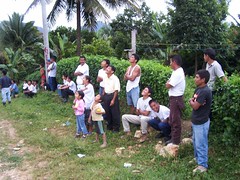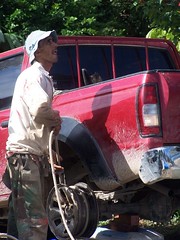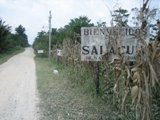Also, about six months ago some new towers went up across the Chixoy River in the Quiche department that gave everyone a sort of hope that maybe their phones could grab signal in special "spots", in fact the large open field next to our house has had a faint signal if you stand in the right place for enough time and learn the tricks such as shutting-of and restarting your phone 3 times in succession while raising your left hand in the air. This ghost signal has created a culture of small groups that congregate in these "spots" with their phones every night, partially to make phone calls but also to pass time.
This is all about to change, as this week we noticed a large metal object growing in Salacuim's skyline, a shiny new cell phone tower! The rumor is that we will have real cell phone signal before Christmas. A team of 6 Colombian and Nicaraguan workers (better described as Trapeze artists) are throwing up a 130 meter tall tower that promises cheap, clear phone calls and the ability to actually receive calls in the last few months of our Peace Corps Service.
Construction Methods:
Although these guys don't have all of the safety gear required in the US, I'm impressed with their use of resources. There is no crane, but they can secure a metal section of ladder to the tower with rope and use it as a boom. From there they run a rope through a pulley system to the rear wheel of a pickup truck up on blocks. To lift sections of the tower, they start the pickup, put it in gear and use it as a crane.
Development:
An adviser to our NGO talks about development of the area as a balance between infrastructure, education, political organization, and environmental conservation; calling them the 4 "capitals". Things like education and political organization are just as important to the development of Salacuim, but they are intangible, hard to see, and actually take more time.
Infrastructure, however, is very tangible and visible. We arrived in Salacuim about 10 years after they were connected to Cobán with a gravel road. The electricity came about 4 months before we arrived, and a previous Peace Corps volunteer told us about the drastic difference: TV's, later nights on the street, etc. Earlier this year, all of the side streets were leveled and lined with gravel; a huge improvement to the steep, slippery paths of before. Offices have also been built for the local organizations: the youth group, the farmers group, and the womens group. In the near future, running water and road paving projects are in the works. We have to look at how much the face of this area is changing and just be amazed.

Tower construction acrobatics

The tower construction site is the most popular community gathering spot

Use of pick-up as a crane






No comments:
Post a Comment